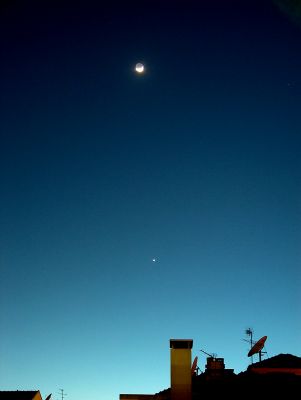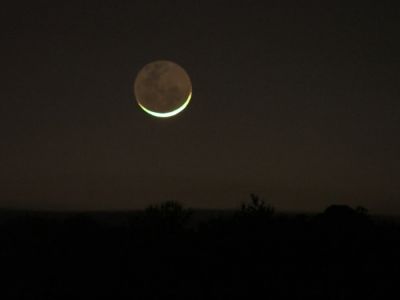Earthshine
Contents


Miguel Claro, The crescent Moon and its dark side. Right: Rob Kaufman, Earthshine on the waning crescent moon.
Images
LPOD Photo Gallery Apollo Images
Earthshine photographs made during the last Apollo mission :
- 35 mm Nikon images made during Apollo 17 (contains lots of B-and-W Earthshine photographs of the moon's nocturnal western hemisphere!). Research Danny Caes.
Description
Illumination of the Moon by sunlight reflected from the Earth. Just as the Earth receives light from the Moon, the Moon receives light from the Earth. However, the phases are complementary: that is, when the Moon is "full" as seen from the Earth, the Earth is dark as seen from the Moon, and vice versa. In addition, according to the NASA Moon Fact Sheet the Earth is 3.67 times larger (in radius) and about 3 times as reflective as the Moon. Since they are the same distance from each other this means that at any given phase the earthshine reaching the Moon is roughly 3.67²x3 = 40 times brighter than the moonlight we are accustomed to on Earth (actually somewhat more, since the moonlight we see has been attenuated by the Earth's atmosphere).
Additional Information
- Bill Anders, one of the three astronauts of Apollo 8 (December 1968) commented on visibility of the lunar surface in Earthshine:
070:09:13 Anders: Earthshine is about as expected, Houston. Not as much detail, of course, as in the sunlight, but you can see the light craters quite distinctly, and you can see the albedo contacts quite distinctly. And, also, the - there's a good three-dimensional view of the rims of the larger craters. From Apollo 8 Journal. - Many space-artists and illustrators have always made wonderful and mysterious looking paintings and drawings of lunar landscapes illuminated by the bluish Earthshine. Perhaps the most well-known examples of this sort of artwork are the extraordinary paintings made by Chesley Bonestell.
- Two of those paintings are online in Fabio Femino's Fantascienza website, on the fifth page dedicated to Chesley Bonestell (the two panoramic paintings on top of that page).
- The top painting on page 14 of Fabio's -Chesley Bonestell- retrospective shows a curious "rough" lunar landscape illuminated by yellowish solar light and bluish Earthshine. Note that such view was also captured by the Clementine orbiter and the Japanese Kaguya orbiter.
- The second page of Fabio's -Collier's- retrospective shows two Earthshine paintings near the bottom of that page. The upper one is the well-known painting of the manned expedition in crater Harpalus, illuminated by bluish/greenish Earthshine (floor of the crater) and yellowish sunlight (inner part of Harpalus' rim). The second painting shows a final departure, illuminated by bluish Earthshine.
- Don Davis' painting of the Full Earth and sunlit lunar polar region (which is a typical example of how the moon is illuminated by bluish Earthshine).
- William K. Hartmann's painting of bluish Earthshine on a lunar crater's floor (note the yellowish sunlight on the crater's opposite inner slope!).
(online search for Earthshine paintings to be continued...). - In the National Geographic of january 1965 (page 127 of the article The Making of an Astronaut) Robert R. Gilruth described the possibility of an early manned lunar landing illuminated by Earthshine, not by direct sunlight. Page 226 of the N.G.'s february 1969 issue (the article That Orbèd Maiden...The Moon) shows a photograph of astronaut Don Lind while exercising at NASA's Manned Spacecraft Center to set out an ALSEP station, illuminated by dim bluish light. This photograph shows very well how a lunar landing would have looked like in earthshine.- DannyCaes Jan 13, 2011
Possible brightness enhancement of Earthshine caused by atmospheric optical effects known as the Primary Cloudbow and the Glory
- The Primary Cloudbow (or Cercle d'Ulloa, also called Fogbow) is a not well-known equivalent of the Primary Rainbow, without vivid spectral colors. The cloudbow looks like a white diffuse circle with radius of about 40 to 45 degrees around the anti-solar point (180 degrees of the true sun). Although it is frequently observable on mountains surrounded by sunlit fog, or on clouddecks (from airliners above the clouds), few mountaineers and airliner-passengers seem to be familiar with it. Simultaneously appearing is the Glory, a multispectral colored effect at small angle around the anti-solar point.- DannyCaes Apr 29, 2009
- Both optical effects (the Primary Cloudbow and the Glory) could enhance the brightness of the Earthshine on the moon. The Cloudbow when the moon is at an angle of about 40 to 45 degrees of the sun, and the Glory when the moon is at very small angle of the sun (Full Earth).
- DannyCaes Aug 3, 2008
Caution:
The visibility of a bright lunar crescent with Earthshine at the moon's nocturnal part is NOT the same as a partial lunar eclipse!
Earthshine, shaky telescopes, and the Pulfrich effect
- Observing both the moon's sunlit crescent and the nocturnal earthlit part through a small telescope with poor "shaky" mount (a weak tripod disturbed by wind) shows a remarkable example of the Pulfrich effect! (a delay in the shaky movement of the earthlit part versus the sunlit crescent).
- The Pulfrich effect is also noticeable in a partially eclipsed moon. Research Danny Caes.
The Pulfrich effect and double star observing
- A curious example of the Pulfrich effect was printed on pages 196-197 of T.W.Webb's Celestial Objects for Common Telescopes, Volume Two: The Stars.
- (Epsilon Pegasi, Enif)
- "This object, when near the meridian, will exhibit a phenomenon, noticed by Herschel: the pendulum-like oscillation of a small star in the same vertical with a large one, when the telescope is swung from side to side. This, he thinks, is due to the longer time required for a fainter light to affect the retina, so that the reversal of motion is first perceived in the brighter object. I have seen this strikingly in Delta and Zeta Orionis, and Delta Herculis".
- See also page 167 of M.G.J.Minnaert's Light and Color in the Outdoors (Oscillating Double Stars).- DannyCaes Feb 12, 2011
- - The same effect is noticeable at the open cluster NGC 2362 in Canis Major (aka Tau Canis Majoris Cluster), of which its brightest star (Tau CMA) is nicknamed "Mexican Jumping Star" because of its independent "jumping" against the background of the cluster's faint stars, whenever there's a little bit of shaking at the tube of the telescope.- DannyCaes Feb 12, 2011
Irradiation
- This optical effect (the seemingly "large" sunlit crescent versus the "small" nocturnal earthlit part) is mentioned on pages 127-128 of M.G.J.Minnaert's Light and Color in the Outdoors.- DannyCaes Feb 12, 2011
Bailly and the Dorfels (an interesting Earthshine-related observation by Harold Hill)
In Harold Hill's splendid book A Portfolio of Lunar Drawings there's an interesting telescopic observation of a shadowed (yet dimly illuminated) mountain range at the moon's south-southwestern limb, a mountain range which was once called Montes Doerfel (or Dorfel). On page 131 of that book, Mr.Hill added a drawing of what he observed during the nocturnal morning hours of september the 27th, 1951. It shows the Dorfel range with five sunlit peaks, and the lower part of the Dorfel's mass in a dim light, of which Mr.Hill thought it could have been Earthshine (at that day in 1951, the moon was at its Waning Crescent phase, and, as seen from the moon, the Earth should have been at Waxing Gibbous).
Now, could it (this weak illumination) have been a combination of Earthshine and reflected light of nearby sunlit slopes slightly east of the Dorfel range?
Research Danny Caes.
Transit of the moon across the bright globular star cluster Messier 22 in Sagittarius
Question:
Are there observations and photographs of the moon's nocturnal part (First Quarter Moon/ Last Quarter Moon) made during the occultation of the thousands of stars in the core of the globular star cluster Messier 22? (the only bright globular cluster which is located slightly south of the ecliptic, on the moon's path).
- DannyCaes May 17, 2015
LPOD Articles
- New and Old Together
- Sun, Moon and Stars
- Two to One
- Maximum Earthshine
- A Smarter View
- Two Views in One
- Five to One
- Monitoring Earthshine
- An Overlooked Gem
- Leonardo's Light
- Why not Venus?
- Yesterday's News (C0SMIC EDITION)
- Sky Candy
- Threesome
- Twirling World (J-P Metsavainio's rather "unusual" look at the moon and at the Earthshine)
- The Last Dark Age
- Milk of Plato (an interesting observation by Phil Morgan, of possible Ashen Light on the floor of Plato).
APOD Articles
Lunar 100
- L2: Twice reflected sunlight.
Bibliography
- Jones, A. et al (2014). An Advanced Scattered Moonlight Model – ESO’s The Messenger (see Astronomical Science section) - No 156, June 2014.
- Planetshine: Wikipedia article